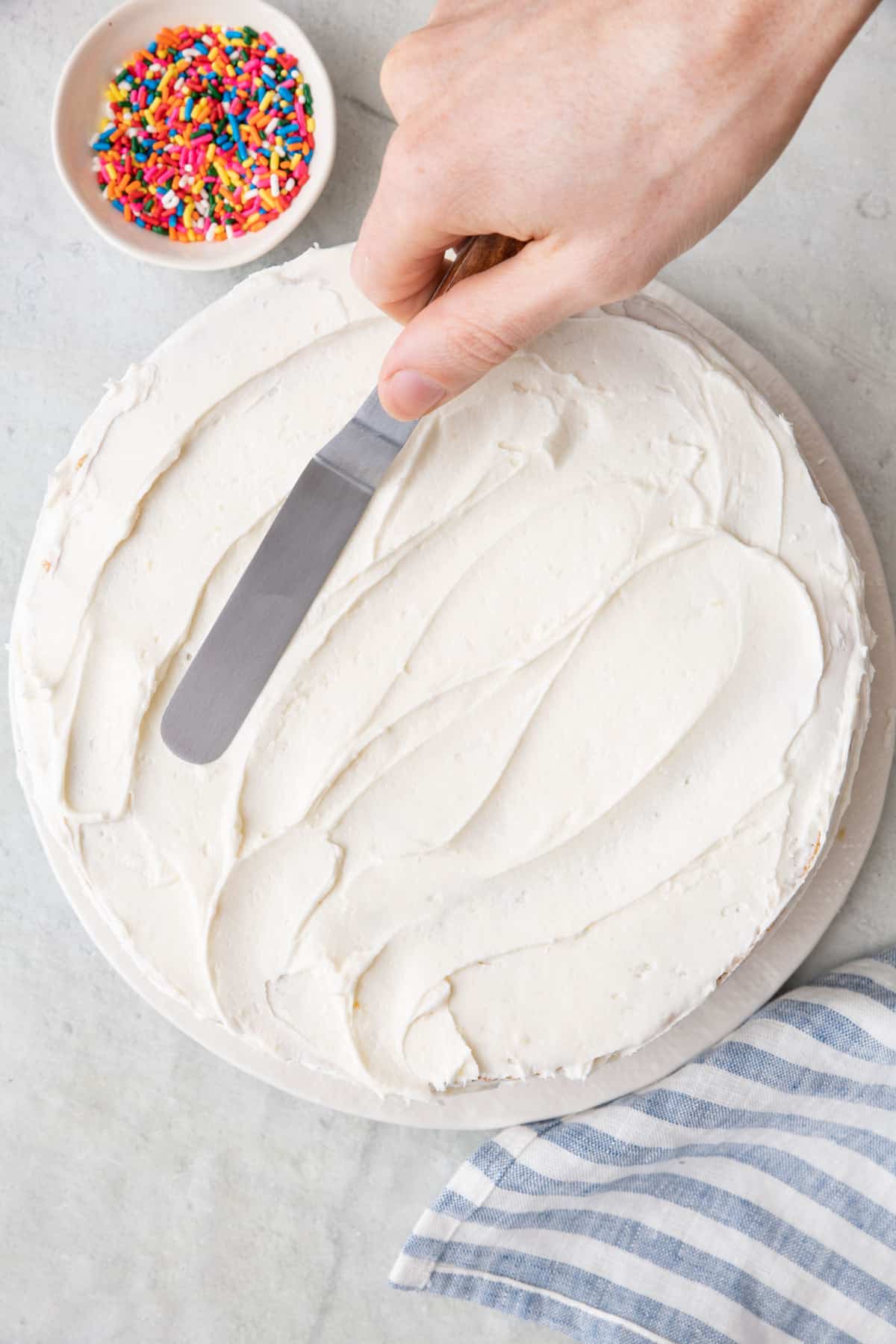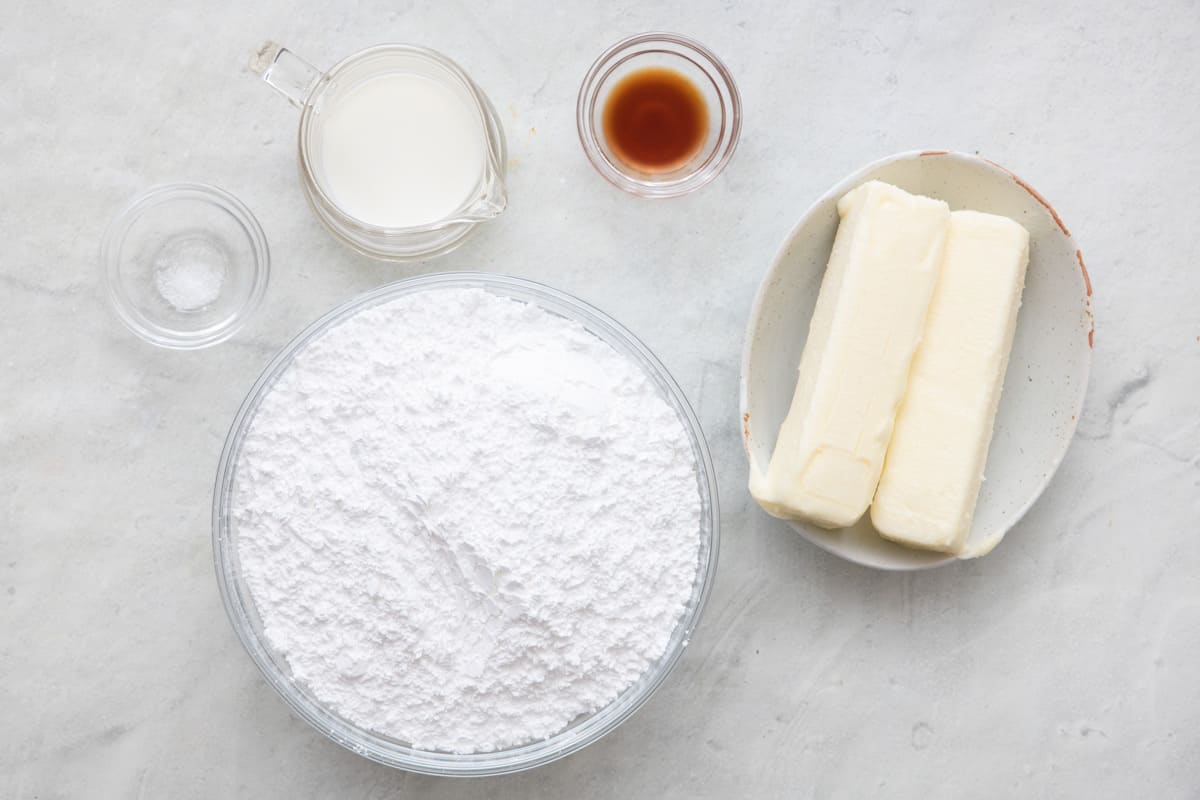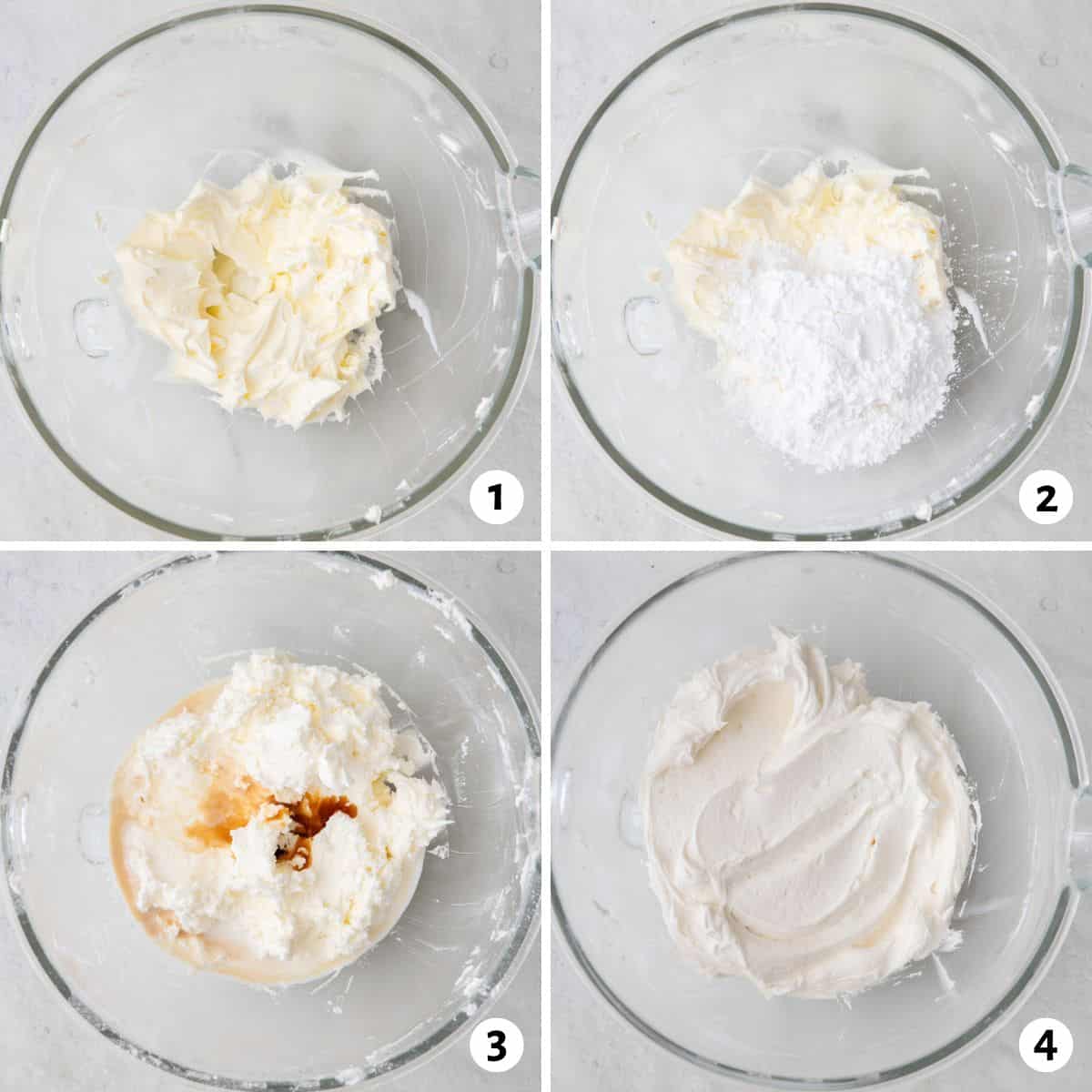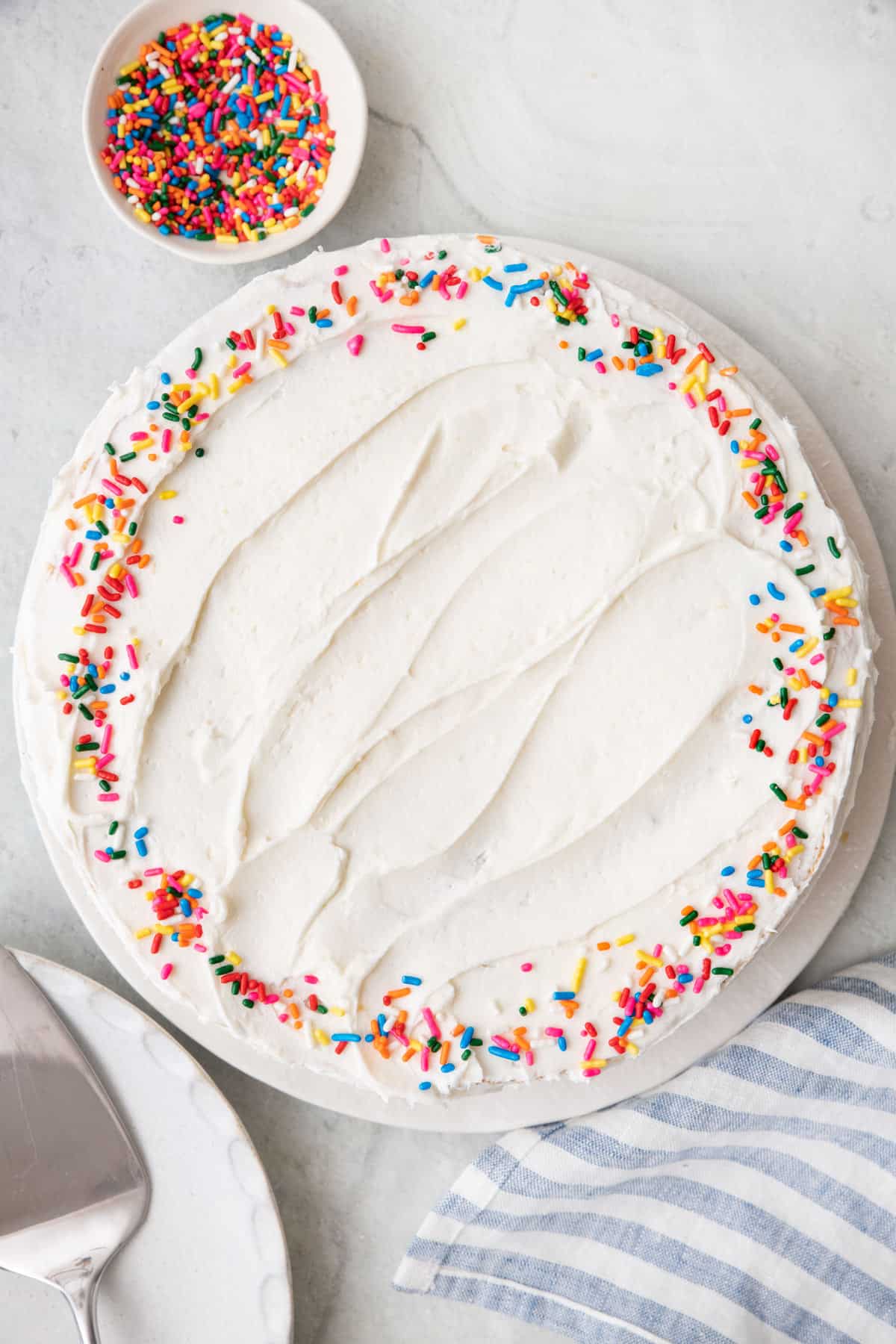This post may contain affiliate links. Please read our disclosure policy.
Skip the storebought stuff and learn how to make frosting with this easy-to-follow guide and just 5 simple ingredients! This classic vanilla frosting is spreadable, can be piped, and has the best sweet flavor. Not only is this buttercream frosting better than storebought, but it’s also adaptable enough to match any cake flavor by adding in extracts and other additions with a smooth, velvety finish.

Table of Contents
- What is Frosting?
- WHY learn to make frosting
- Ingredients to Make Frosting from Scratch
- HOW TO MAKE Frosting
- TIPS FOR the Best Frosting
- popular SUBSTITUTIONS & additions
- recipes to use with buttercream frosting
- HOW TO STORE Homemade Frosting
- FREQUENTLY ASKED QUESTIONS
- MORE cooking tutorials:
- How to Make Buttercream Recipe
What is Frosting?
Frosting is a whipped topping made from creaming butter and sugar together until light, smooth, and fluffy. It’s made for topping cakes and cupcakes and uses an offset spatula for spreading onto them or for filling a piping bag for adding decorative decorations.
There are 4 different types of frosting that are commonly used. The frosting recipe we’re learning today is an American buttercream.
- American Buttercream: This is known as a “quick buttercream” that mixes together confectioners’ sugar, softened butter, and usually milk or heavy cream. The most common quick and easy frosting recipe that goes with cake, cupcakes, and topping cookies.
- Cream Cheese Frosting: Room temperature butter and cream cheese are whipped together until smooth and creamy then adding powdered sugar for sweetening it. This type of frosting is common on cupcakes, spice cakes, carrot cakes, and banana bread.
- Swiss Meringue Buttercream: This egg white base frosting beats egg whites with sugar over a double boiler to cook the base before adding in the butter and sugar. A fantastic frosting for piping defined flowers and embellishments on cakes.
- Whipped Cream Frosting: Heavy cream is whipped with powdered sugar until firm peaks form and is used on parfaits, cheesecakes, and ice cream. I love adding a dollop to pumpkin pancakes, too! It’s commonly less sweet than other frostings.
WHY learn to make frosting
If you love a good, solid frosting recipe that is versatile, easy to make and uses common ingredients, you’re going to love making frosting from scratch every time. Once I started making my own buttercream at home, I never turned back to using storebought again! It’s just TOO EASY to make yourself and I love that this base frosting recipe can be built on to create more flavors so I can decorate any cake just by adjusting a few ingredients.
- Made with simple ingredients. This classic vanilla buttercream uses just 5 basic ingredients: unsalted butter, confectioner’s sugar, vanilla, and milk with a pinch of salt.
- It’s extremely versatile. This recipe is perfect as is for a smooth, fluffy frosting, but can also be the start of another frosting recipe. From switching up the vanilla for other extracts to adding chocolate or other flavors to match the recipe you’re making it for, you’ll find making this recipe from scratch has many options to work with.
- It’s more rewarding than using storebought. Sure, you could buy the premade stuff, but there’s something about making cake and frosting from scratch that is very rewarding. Plus, it tastes better, too!
- Smooth, velvety perfection. Whipped up until the consistency is fluffy, spreadable, and smooth which is great for spreading on with a cake spatula or used in a pipping bag for those added embellishments.
Ingredients to Make Frosting from Scratch
- Unsalted butter: Using unsalted allows you to control the salt content and salted butter can vary largely by brand. If you like making your own butter, this could be a fun recipe to use it with.
- Confectioner’s sugar: Also referred to as powdered sugar, this should be sifted before adding it to the butter for a smooth frosting.
- Milk: This recipe uses whole milk but you could also use heavy cream or a non-dairy alternative such as coconut milk or nut milk.
- Vanilla extract: Choose pure vanilla extract instead of imitation flavoring as it can sometimes have a bitter aftertaste. You could use other extracts such as lemon or almond.
- Salt: a pinch of salt is just enough to balance the sweetness and enhances the flavor.

HOW TO MAKE Frosting
- Cream the butter using a stand mixer with the paddle attachment until the color has lightened and is fluffy.
- Sift powdered sugar and add a cup at a time, scraping down the sides as needed until incorporated and smooth.
- Add the vanilla and milk.
- Continue mixing until the frosting is very light and fluffy.

TIPS FOR the Best Frosting
- Sift the sugar. Sometimes sifting feels like a lot of work, but in this case, I strongly suggest that you don’t skip it. This is what will ensure your frosting is light, fluffy, and smooth.
- Use room temperature butter. This is very important when making frosting because room temperature butter can hold air and makes the final frosting more light and airy, whereas warm or melted butter will create a denser result. Learn how to soften butter four different ways.
- Scrape down the sides as you go. When creaming the butter, add the sugar, and towards the end, continue to scrape down the sides when needed to ensure that everything is well incorporated. This will give you a smooth and fluffy frosting.
- Create a smoother finish. Turn the mixer to low speed at the end for about 30 seconds to help remove any large air pockets for a smoother finish.
popular SUBSTITUTIONS & additions
- Mix up the Flavors. Swap the vanilla extract for citrus zest, peppermint extract, or almond extract based on what you are using it for!
- Add food coloring. I like to use natural food dyes and add a few drops depending on what the occasion is to transform the frosting color into something special.
- Make a chocolate frosting. Add in a ½ cup of sifted unsweetened cocoa powder to the powdered sugar before adding it to the butter. You can adjust the milk if needed for the right consistency.
- Try it dairy-free. Substitute the butter and milk for their dairy-free plant-based alternatives.

recipes to use with buttercream frosting
There are a few different ways to use buttercream frosting, cake and cupcakes are a must! But you can also try it on a few other sweets.
- Classic Vanilla White Cake
- Mug Cakes
- Cupcakes
- Sugar Cookies or Ginger Snap Cookies
- Carrot Cake Muffins
HOW TO STORE Homemade Frosting
Store buttercream covered in the fridge. To reuse, bring to room temperature and rewhip for the best consistency.
HOW LONG WILL Buttercream Frosting LAST IN THE FRIDGE?
Frosting can be stored in the fridge for 3 days but is best used fresh.
CAN I FREEZE Frosting?
You can store the frosting in an airtight container or freezer bag for up to 3 months. Thaw in the refrigerator the day before and bring to room temp before re-whipping and using.
FREQUENTLY ASKED QUESTIONS
This buttercream makes enough to cover a 9 x 13 sheet cake, a two 9-inch round layer cake, or 24 cupcakes.
The words frosting and icing are primarily interchangeable in terms of naming the recipe, and it is common to hear “frosting” be called “icing.” But in short, frosting is typically fluffy, thick, and spreadable compared to icing, which is thin and pourable. Icing combines powdered sugar and a liquid such as milk or cream.
You can make frosting 2-3 days ahead of time and store it in the fridge, or freeze up to 3 months.
If it’s all you have, then frosting can be made with salted butter but results with vary. Each brand has different levels of salt in them, which is why unsalted is preferred.

This handy guide on making frosting at home is easy to follow, and you’ll be grateful to have an adaptable recipe in your collection to create more and more sweets. A simple buttercream frosting is perfect for decorating cakes and cupcakes but also delicious as a cookie sandwich filling! Try a few different cake and cookie recipes with this classic vanilla frosting.
MORE cooking tutorials:
- How to Make Cashew Cream
- How to Make Apple Butter
- How to Make Candied Walnuts
- How to Freeze Strawberries
- How to Make Whipped Cream
- How to Make Jam
- How to Make Popsicles
- How to Make Fruit Leather
- How to Make Pie Crust
- How to Make No Churn Ice Cream
- How to Make Glaze
If you found this tutorial for How to Make Frosting helpful or if you try any recipe on Feel Good Foodie, then don’t forget to rate the recipe and leave a comment below! It helps others who are thinking of trying out this tutorial and we would love to hear about your experience. And if you snapped some shots, share it on Instagram so we can repost on Stories!

order MY book
The Feel Good Foodie Cookbook is now available everywhere books are sold!
Amazon TargetBarnes & Noble Books A Million Hudson Booksellers BookshopSCHULER Books

How to Make Buttercream
Ingredients
- 2 sticks unsalted butter at room temperature
- 4 cups Powdered sugar sifted
- 3 tablespoons whole milk
- 1 teaspoon vanilla extract
- pinch salt
Instructions
- Add butter to the bowl of a stand mixer fitted with the paddle attachment. Mix at medium speed for 2 to 3 minutes, or until it starts to lighten up in color and turn fluffy.
- Stop the machine and scrape down the sides of the bowl with a rubber spatula. Add 1 cup confectioner’s sugar at a time until it has all been incorporated. Add milk, vanilla and salt and continue to mix until the mixture is very light and fluffy, about 1 to 2 minutes.
- Use immediately, or store in the fridge, tightly wrapped for up to 3 days. Let come to room temperature and re-whip before using.
Notes
Nutrition
Nutrition information provided is an estimate. It will vary based on cooking method and specific ingredients used.






The recipe doesn’t say how much of each ingredient to use
Hi Linda, right above the comments you’ll find a recipe card complete with the full instructions as well as ingredient measurements. Hope that helps!
Would this work with salted butter if I omitted the pinch of salt?
If it’s all you have, then frosting can be made with salted butter but results with vary. Each brand has different levels of salt in them, which is why unsalted is preferred.